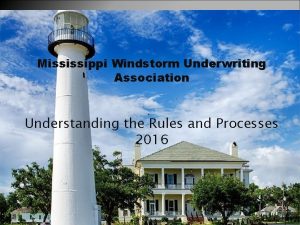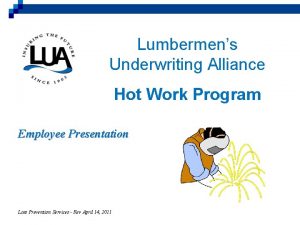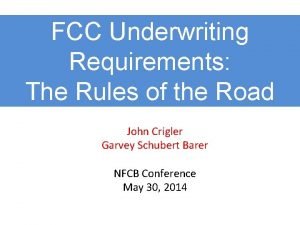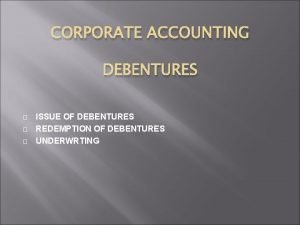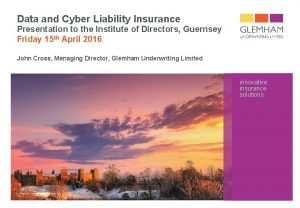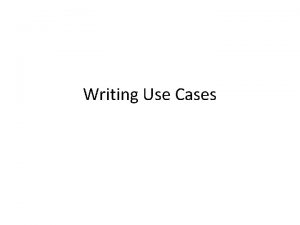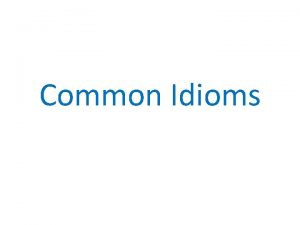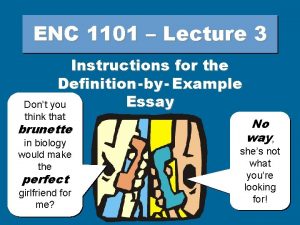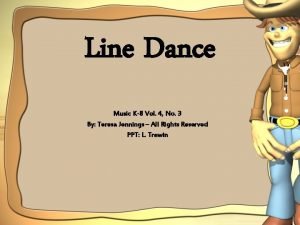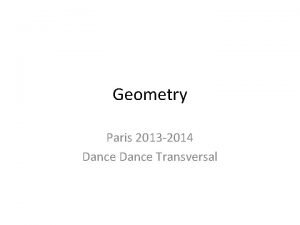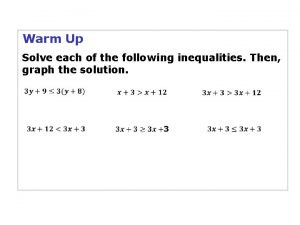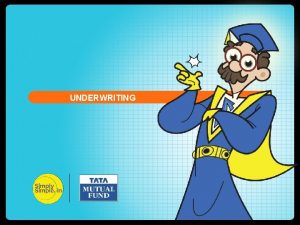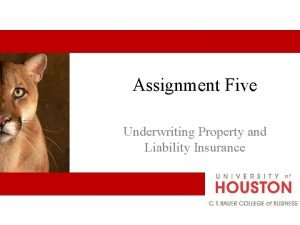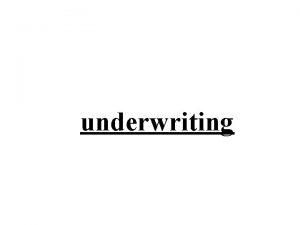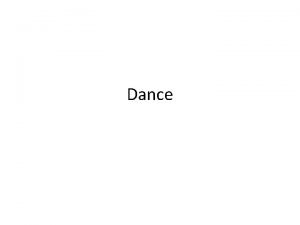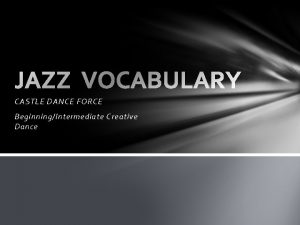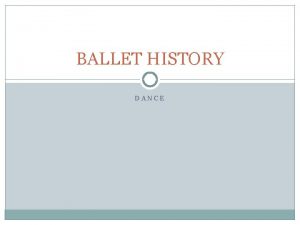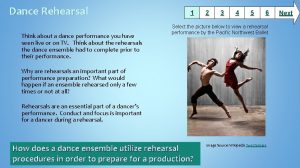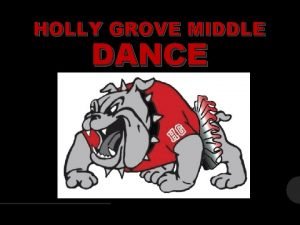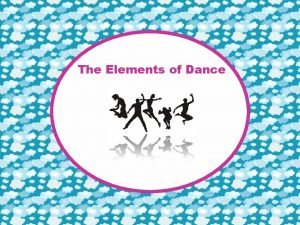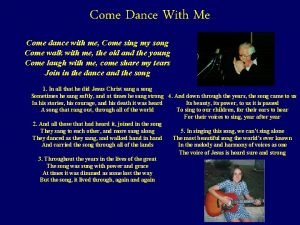Are You Dressed for the Underwriting Dance Dance


































- Slides: 34

Are You Dressed for the Underwriting Dance

Dance Card Members of STRIMA Highlight Program Changes Fox Trot Underwriting Specifications Tango Location Schedule Waltz Loss History Rhumba

Dance Partner Steve Wlodarski Executive Underwriter Public Entity Group Allianz Global Corporate and Specialty North America Joined Allianz in 2002 as an Executive Underwriter Risk Management Property Team at CNA for over 5 years. Underwriting of accounts headquartered in the eastern United States. Zurich Insurance until 1997, where he gained experience in underwriting accounts with international exposure. Underwriting experience started in 1990 with Allendale (FM Global) working on HPR accounts for more than 5 years. Insurance career began in 1985 providing loss prevention inspections and reports for Insurance Services Office (ISO) and then Improved Risk Mutual (IRM). Education - Northern Illinois University (GO HUSKIES) with a Bachelor of Science in Finance and has completed several courses toward the CPCU designation. Dance Instructor – Arthur Murray Dance Studios Choreographer – Dancing with the Stars

Accurate Location Schedule – Why is it Important • • Rates based on the following… Construction Occupancy Protection Exposures Loss History Catastrophe Modeling

Location Schedule – Information Needed • • • Description / Occupancy Street Address City State Zip Code Building Square Footage

Location Schedule – Information Needed (Continued) • • • Building Value Contents Value Vehicles Computers Fine Arts Total Insured Values

Location Schedule – Information Needed (Concluded) • • • Building Construction Type (ISO 1 – 6) Number of Stories Year Built Sprinklered or Non-Sprinklered Flood Zone (If known)

ISO CONSTRUCTION CODES ISO Fire Classification Class Name 0 Unknown 1 Frame Buildings having wood exterior walls or other combustible materials including construction where combustible materials are combined with other materials such as brick veneer, stone veneer, iron cladding, or stucco on wood. 2 Joisted Masonry Buildings having masonry exterior walls, such as stone, adobe, brick, clay tile, concrete block, or concrete, with combustible joisted wood floors and roof. 3 Non-Combustible Buildings having walls and floors constructed of, and supported by non-combustible materials such as metal, concrete, asbestos, gypsum, or fire-proofed steel. 4 Masonry Non-Combustible Buildings having exterior walls constructed of unit masonry, such as stone, adobe, brick, clay tile, or concrete block, with floors and roof of metal or other non-combustible material. 5 Modified Fire Resistive Buildings having exterior walls, floors, and roof constructed of masonry or other fire-resistive material with a fire resistance rating of one hour or more, but less than two hours. 6 Fire Resistive Buildings having exterior walls, floors , and roof constructed of masonry or other fire-resistive material with a fire resistance rating of not less than two hours.

Various Construction Descriptions Construction Type Limestone/Granite Masonry Brick/Concrete Masonry / Brick Masonry / Granite Brick / Precast Concrete Brick / Stucco Steel / Metal panels Limestone Brick / Cement Panels Metal Stucco Concrete

Why Accuracy of Values is IMPORTANT • Premium • Loss Adjustment • Overall Indicator on Reliability of Information provided

Factors Impacting CAT Modeling – EQ, Flood and Named Windstorm • Complete Address including Number, Street Name, City, State and Zip Code • Accurate Values for Building and Contents • All of this Information is obtained from the Location Schedule

Named Windstorm - Construction – Secondary Characteristics 1 - Percent Complete 0 - Unknown 1 - Completed 2 - 80 to 100 % complete 3 - 50 to 80% complete 4 - Less than 50% complete 5 - Roof Maintenance 0 - Unknown Well-maintained roofs tend to hold up better under high wind conditions. 1 - Building maintenance enforced 2 - No building maintenance 6 - Roof Age 0 - Unknown 1 - Zero to five years 2 - Five to ten years 3 - Ten years or more Older roofs may a higher risk in a hurricane.

Construction – Secondary Characteristics (Continued) 8 - Roof Parapets 0 - Unknown Roof parapets hang off the edge of roofs and may be a risk in high winds. 1 - Presence of parapets (greater than 3 feet) 2 - No parapets (or parapets less than 3 feet) 10 - Mechanical and Electrical Systems (Roof Only) 0 - Unknown 1 - No equipment and/or skylights If there are large areas of roof covered with equipment, the building can be more vulnerable to wind because the equipment anchorage can compromise the roof’s integrity. 2 - Equipment securely anchored to roof structure 3 - Small area of roof covered by poorlyanchored equipment or skylights 4 - Substantial area of roof covered by non- or poorly-anchored equipment or skylights 12 - External Ornamentation 0 - Unknown 1 - Little ornamentation 2 - Average amount of ornamentation 3 - Heavy ornamentation Ornamentation includes all elements that can shake loose from either the roof or structural elements of the building.

Construction – Secondary Characteristics (Continued) 14 - Cladding Rating 0 - Unknown For cladding that is specifically designed and installed for extreme wind loading, the design documents state that engineering review of the cladding has been performed. 1 - Designed for extreme wind loading 2 - Product evaluation report 3 - Not specifically designed for extreme wind loading and/or product evaluation 16 - Architecture Elements 0 - Unknown 1 - None The presence of many architectural elements, such as tall parapets, overhangs, and carports are vulnerable and may cause increased wind damage to the structure. 2 - Canopies, roof overhangs, carports, parapets 17 - Mechanical and Electrical Systems (Building Side Only) 0 - Unknown 1 - None 2 - Generally braced 3 - Generally non-braced Mechanical and electrical systems that are attached to external walls can receive damage from high winds.

Construction – Secondary Characteristics (Continued) 19 - Wind Resistance of Window Openings 0 - Unknown Windows with poor wind resistance can expose interior building components and contents to more wind and water hazards than windows with good wind resistance. 1 - Windows with protection designed for extreme wind loading 2 - Windows with protection not designed for extreme wind loading 3 - Jalousie or awning windows 4 - Casement windows 5 - Sliding windows 20 - Wind Resistance of Door Openings 0 - Unknown 1 - Good design for wind protection 2 - Average design for wind protection 3 - Not designed for wind protection 4 - No door Doors with poor wind resistance can expose interior building components and contents to more wind and water hazards than doors with good wind resistance.

Construction – Secondary Characteristics (Concluded) 23 - Wind-Driven Missile Exposure 0 - Unknown 1 - None 2 - Airborne small missiles, gravel, foliage 3 - Protective foliage 4 - Gravel ballast present on buildings 5 - Potential severe missile exposure 6 - Isolated large trees Buildings may receive damage from airborne missiles, gravel, or from trees within falling distance.

Named Windstorm – No Secondary Characteristics

Named Windstorm – Probable Maximum Loss (PML)

Named Windstorm – Event Analysis

Named Windstorm – Including Secondary Characteristics

Named Windstorm – Probable Maximum Loss (PML)

Named Windstorm – Event Analysis including Secondary Characteristics

Earthquake - Secondary Characteristics Shape Configuration 0 - Unknown Configurations can be regular (square, rectangular, circular) or irregular (L-shape, T-shape, triangular). Irregular buildings tend to twist in addition to shaking laterally. Damage often occurs at the corners between different wings of a building. 1 - Regular 2 - Irregular Setbacks and Overhangs 0 - Unknown Significant setbacks and overhangs can cause irregular structural performance in an earthquake. Resulting stress concentrations can lead to further damage. 1 - No 2 - Yes Cladding 0 - Unknown 1 - No Cladding 2 - Glass or Precast Concrete 3 - Unreinforced Masonry Even though they have little or no structural value, the cladding elements, such as an exterior wall of unreinforced masonry on a wood frame home, can cause significant loss if they sustain serious damage. Note: This will have the most impact if the cladding is Unreinforced Masonry.

Earthquake – Secondary Characteristics (Continued) Ornamentation 0 - Unknown Decorative elements that are attached to the exterior of a building and could fall off during an earthquake, such as unbraced parapet walls. 1 - Little or None 2 - Average 3 - Extensive Frame Bolted Down 0 - Unknown Unbolted buildings may slide off their foundations during a strong earthquake, causing significant damage. Anchoring the frame to the foundation has proven to be the best means of protection against earthquake damage in frame structures. 1 - Bolted 2 - Unbolted Purlin Anchoring (AKA "Tilt-up Retrofit") 0 - Unknown 1 - Properly Anchored 2 - Not Properly Anchored In older tilt-up structures, connections between the tilt-up walls and the roof framing system were designed inadequately for earthquake resistance. The failure of these connections can be prevented by the addition of special anchors.

Earthquake – Secondary Characteristics (Concluded) Mechanical & Electrical Equipment 0 - Unknown Damage to mechanical and electrical equipment can be prevented by anchoring such equipment to the floor and/or bracing it against structural elements. 1 - Generally Well Braced 2 - Somewhat Braced 3 - Generally Unbraced Pounding 0 - Unknown Pounding occurs when there is little or no clearance between adjacent buildings, and the buildings impact or "pound" against each other as they sway during an earthquake. 1 - No 2 - Yes Tank 0 - Unknown 1 - No 2 - Yes Rooftop tanks on adjoining, higher buildings are a falling hazard during an earthquake.

Earthquake – No Secondary Characteristics

Earthquake – Probable Maximum Loss (PML)

Earthquake – Event Analysis

Earthquake – Including Secondary Characteristics

Earthquake – Probable Maximum Loss (PML)

EQ – Event Analysis including Secondary Characteristics

Quiz Connect the Logos

Answer “S” for STRIMA S

You Are Now Ready For The Underwriting Dance!
 Mikael ferm
Mikael ferm Dance dance dance in the freedom we know
Dance dance dance in the freedom we know Royal london medical underwriting limits
Royal london medical underwriting limits Wind and hail insurance biloxi ms
Wind and hail insurance biloxi ms Insurance workflow automation
Insurance workflow automation Partial underwriting
Partial underwriting Lumbermens underwriting alliance
Lumbermens underwriting alliance Debt underwriting
Debt underwriting Fcc underwriting rules
Fcc underwriting rules Hpap underwriting guidelines
Hpap underwriting guidelines Journal entry for underwriting commission
Journal entry for underwriting commission Glemham insurance
Glemham insurance Fully dressed use cases
Fully dressed use cases Fully dressed use case
Fully dressed use case Beef steak market form and meat cut
Beef steak market form and meat cut Teddy bear jump rope rhyme
Teddy bear jump rope rhyme Are cut evenly from large slabs of frozen fillets
Are cut evenly from large slabs of frozen fillets She was dressed to the nines figurative language
She was dressed to the nines figurative language Dinner is on the house figurative language
Dinner is on the house figurative language Figurative opposite
Figurative opposite Who perform a smartly dressed parade
Who perform a smartly dressed parade She was dressed in rich materials
She was dressed in rich materials All dressed up and nowhere to go meaning
All dressed up and nowhere to go meaning To get dressed
To get dressed Orbital body cavity
Orbital body cavity Hurry up and get dressed
Hurry up and get dressed She was dressed to the nines figurative language
She was dressed to the nines figurative language Cha cha sline
Cha cha sline Everybody dance and sing line dance
Everybody dance and sing line dance Geometry bell ringers
Geometry bell ringers Inequalities warm up
Inequalities warm up Dance is just a hobby.
Dance is just a hobby. Fspos vägledning för kontinuitetshantering
Fspos vägledning för kontinuitetshantering Novell typiska drag
Novell typiska drag Nationell inriktning för artificiell intelligens
Nationell inriktning för artificiell intelligens



